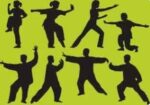 Tai chi is often cited as one of the world’s most popular physical activities. It originated in China in the 17th century as a martial art, though it focuses on quiet strength rather than combat, which makes it more accessible to older adults. The name tai chi refers to both the physical practice and the underlying philosophy of yin and yang — that there’s no good without bad, no dark without light.
Tai chi is often cited as one of the world’s most popular physical activities. It originated in China in the 17th century as a martial art, though it focuses on quiet strength rather than combat, which makes it more accessible to older adults. The name tai chi refers to both the physical practice and the underlying philosophy of yin and yang — that there’s no good without bad, no dark without light.Qi Pouring
Stand with your feet shoulder width apart. Bend your knees gently, pick up your left foot and take a large step to the left. Center your body weight. Begin rocking back and forth by lifting your heels, then your toes, then your heels again.
Each time you come forward onto your toes, bring your arms up to chest height with your palms down and your wrists soft. As you rock back on your heels, bring your arms back down to your sides, palms facing back.
Raising the Power
Stand with your feet shoulder width apart, then pick up your left foot and take a large step to the left. Bend your knees into a slight mini-squat as you raise your arms up in front of you, keeping your wrists and hands relaxed. Then press your hands back down as you gradually straighten your legs.
Wave Hands Like Clouds
Stand with feet shoulder width apart, then gently bend knees as you pick up left foot and take a large step to the left. Straighten knees, and as you do, lift your arms to chest height, palms facing down and hands and wrists loose and relaxed. Calmly bend knees back down into a mini-squat, arms in front of you. Turn at your waist so your stomach and chest face right; as you do, shift your weight onto your right leg and brush your right hand up and across, in front of your face, palm facing inward. Once your hand crosses your midline, lower your arm back down.
Repeat in the other direction, turning your torso to the left, shifting your weight onto your left leg, and brushing your left hand up and in front of your face and then back down.
Washing Yourself With Qi From the Heavens
Stand with feet shoulder width apart, then lift left foot to take a large step to that side. Slowly lift your arms up to your sides and then overhead. Circle your hands, palms down, in front of your face and toward the floor. Visualize rejuvenating energy flowing through your body, anchoring you to the ground.
Washing Yourself With Qi From the Heavens
Stand with feet shoulder width apart, then lift left foot to take a large step to that side. Slowly lift your arms up to your sides and then overhead. Circle your hands, palms down, in front of your face and toward the floor. Visualize rejuvenating energy flowing through your body, anchoring you to the ground.

Leave a Reply